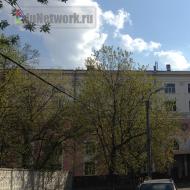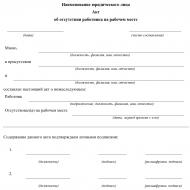
Land town house apartment building. Features of purchasing and registering a townhouse
An intermediate option between an apartment and a private house is a townhouse. All other things being equal, prices for sections in blocked houses are relatively loyal; they are usually easier to maintain than cottages, and they do not have all the disadvantages of ordinary apartments. However, there are more than enough legal features that you should pay attention to when choosing a complex of townhouses.
Can't it be higher than three floors and more than ten sections?
A townhouse, the mention of which immediately imagines several houses connected to each other by side walls, is more of a marketing concept than a legal one. Finding it in Russian legislation is not only difficult, but generally unrealistic: it does not occur in its pure form. And its semantic synonym, blocked development, is present only indirectly, for example in the Town Planning Code, in Article 49, as a description of the type of buildings, the design declaration of which does not require state expertise.According to paragraph 2 of this article, an examination is not required if it is planned to build “residential buildings with no more than three floors, consisting of several blocks, the number of which does not exceed ten and each of which is intended for one family, has a common wall (common walls) without openings with the neighboring block or neighboring blocks, located on a separate plot of land and has access to a common area (blocked residential buildings).”
Does this mean that townhouses should only have no more than three floors, and the number of sections should not exceed a dozen? Not at all. More is possible, but with a mandatory examination, which developers are not very fond of conducting: it takes time (by law - three months) and additional money. Therefore, in the majority of townhouse settlements, they try not to get involved with increasing the number of sections and their number of storeys.
Is a section in a townhouse an apartment or a separate house?
So what are townhouses - apartment buildings “laid on their side”, or several individual houses “attached” to each other? In fact, back on August 26, 2010, the real estate department of the Ministry of Economic Development made an attempt to put an end to this dispute by proposing to classify the blocked development as multi-apartment. As an argument for precisely this approach, we took a phrase from the decree of the Government of the Russian Federation dated January 28, 2006 with a long title “On approval of the Regulations on recognizing premises as residential premises, residential premises unsuitable for habitation and an apartment building as unsafe and subject to demolition or reconstruction.” It says that “an apartment building is a collection of two or more apartments that have independent access either to a land plot adjacent to a residential building or to common areas in such a building,” which fully describes the essence of townhouses.If such a concept were unambiguously enshrined in the legislation, the problem of formalizing the transaction would automatically disappear. Townhouses would be built and sold only according to the laws that are relevant for any “multi-apartment buildings”: either by shared participation in construction (214-FZ), or as a cooperative (215-FZ). However, this has not yet happened, and each section in a townhouse can still turn out to be both an apartment and an individual house. Moreover, in the second case, the buyer may be offered to draw up contracts of various kinds, typical for this type of real estate, including a construction contract. But what kind of legal option for townhouses (a set of apartments or a set of individual houses) a particular buyer will encounter depends on several parameters. For example, on the status and purpose of the land, the specifics of construction and the method of laying communications, as well as on local legislation and the position of the developer himself.
What are the features of a townhouse designed as an apartment?
If the site on which townhouses are being built belongs to the lands of settlements and is intended for low-rise construction (LHC), the house will be considered multi-apartment and each section will accordingly be designed as a separate apartment with an individual entrance. At the same time, the building itself will be subject to the same requirements for construction specifics and engineering as specified in SP 54.13330.2011 “Residential multi-apartment buildings” (this is the currently used type of SNiP 31-01-2003). Similar requirements apply to social infrastructure, as well as maximum distance from it. And if a village of such townhouses is also built in accordance with 214-FZ, it will necessarily have its own project declaration, which will give a full description and completion date of the work, and list everything else that will be built on its territory. And this is not at all superfluous, because the beautiful illustrations of the project that developers use to decorate the websites of their townhouse communities and sales offices do not have legal force and are not required to be implemented at all. But what is specified in the project declaration must be built for sure.Townhouse as an individual home: more expensive or cheaper?
If the site has the status of individual housing construction (individual housing construction), on it, as is clear from the name, only individual houses can be built on it, even if they are connected to each other by walls. What is said in the construction standards SP 55.13330.2011 “Single-apartment residential houses”, which are an updated version of the previously valid SNiP 02/31/2001. Therefore, in the contract with the buyer, a section of such a townhouse will be designated as an individual house (or as a block section, which is less common in practice due to discrepancies in the legislation and the diversity of its interpretation by local registration authorities).But there are some nuances here. As stated in the already mentioned building regulations, neighboring blocks in this case should not have common premises, as is allowed in relation to townhouse-apartments that are built on the lands of the Ministry of Housing Development.
For example, they should not have common attics or basements, through which it is both technically and economically advantageous to carry out utilities common to the entire house and which allow for general waterproofing of the entire building at once. That is, all engineering in each block section must be installed separately and the roofing of each part intended for one family must be made independent of the others. This leads to the fact that construction costs immediately increase (communications alone will rise in price by about 10%), which means that prices will become higher. It is not surprising that developers practically do not follow the letter of the law and, on plots intended for individual housing construction, build according to the same principle as on land intended for individual housing construction.
The second nuance is related to the minimum permissible size of the plot on which it is allowed to build an individual house. Each locality has its own (as a rule, the minimum falls within the range of 1.5–6 acres), which is indicated in local land use rules and the general plan. This means both the land where the block section directly stands and the land around it. If there is less land, there will be big problems with registering the house. However, what makes such townhouses attractive is their land: unlike those built on MHS lands as apartments, these plots are always registered as private property.
Which townhouses are dangerous to buy?
If townhouses that are being built on the lands of settlements intended for individual construction (IHC), at the very least, but still fit into the legal framework, then those that are being built on agricultural lands, allocated for example for dachas, are already beyond the bounds of good and evil. And the point is not even that this is clearly prohibited and such real estate cannot be registered. Quite the contrary: everything is still simpler here than on individual housing construction lands. After all, buildings erected on dacha lands do not require permission to be put into explantation, and they can be registered under the “dacha amnesty”.Or rather, it’s still possible: it expires on March 1, 2018. True, this applies only to individual residential buildings, which are not built on dacha lands, but for all other types of real estate that fall under simplified registration of rights, the “hour H” has not yet been announced by the authorities. However, some punitive measures have been announced and partially implemented. Let’s say, two years ago, when a “black list” of more than a hundred illegally built properties appeared in the Moscow region, it included not only low-rise buildings, but also townhouses. They were “accused” of precisely the fact that they were built on lands for the wrong purpose. And some even demolished them demonstrably, so that others would be discouraged from going the same way. About a year ago, the Moscow region authorities developed a package of amendments to the Land Code, according to which lands with improper use can be seized from the owner. As for the already mentioned “dacha amnesty,” they plan to stop extending the simplified registration scheme to newly built houses altogether.
However, for now, such actions are more like a one-time show of force rather than systematic actions to “tighten the screws.” The reality is different. For objects built on dacha lands, the capacity for engineering communications is not required to be allocated at all, especially in the volumes that are required for houses intended for permanent residence (those built on the lands of individual housing construction and small housing construction). From what sources the developers of such townhouses are going to provide buyers with electricity, gas, water, and whether they are going to do this at all is unclear. By the way, the main complaint of deceived buyers of country real estate is precisely that their houses were never connected to communications. Against this background, the lack of social infrastructure, which is not supposed to be on agricultural lands by default, seems like a trifle. However, this little thing will greatly complicate living. Well, who needs it?
Townhouse plots – whose are they?
A legally impeccable townhouse is one that is being built on the lands of the Ministry of Housing Development in accordance with 214-FZ and is a low-rise apartment building, where each owner has his own entrance. But the land next to each section is a different story. Whose property is it: the personal property of each owner or collective property, as is customary in urban apartment buildings? It is easier and cheaper for the developer to make it collective property, because this will not require any additional investments. Another thing is that buyers may not like this, because when purchasing a townhouse, they expect to receive a piece of land for individual use, on which they can spend time in isolation and where neighbors will not enter without their knowledge.To solve this problem, in those villages where the land is jointly owned, even at the time of concluding the DDU, you can invite each client to sign an agreement on the procedure and features of using the common property. And in it, among other things, indicate the priority right to use that part of the site that is adjacent to a specific section, as well as the possibility or impossibility of erecting, say, gazebos, planting flower beds, etc. on this territory. In other words, give him practically the same rights as the owner of an individual plot, with the exception of the right to sell the land.
Townhouses are one of the most popular formats of suburban housing. But it is also one of the most problematic. During their construction, a number of strict conditions must be observed. Otherwise, ownership will not be registered, and the house may be demolished.
In just two years, a market for townhouses has formed in the suburbs of St. Petersburg - today sales are going on in about 60 projects. This is more than five thousand block sections. At the same time, curiously, in the current legislation the concept of “townhouse” does not exist at all. The question arises: what are we actually buying?
Townhouse or apartment?
The Town Planning Code of the Russian Federation contains the concept of “blocked residential building”. This is an object no more than three floors high, consisting of several sections (no more than 10), each of which is intended for one family. The walls between blocks should not have windows or doors. And it is necessary to have an exit from each block to the public area. This is the “official definition” of a townhouse.
The legal status of the land plot is of great importance. According to the Land Code of the Russian Federation, all plots are divided into categories, as well as types of permitted use. There are several categories - we are only interested in two: lands of settlements and agricultural purposes. Since townhouses are housing, they, accordingly, must be built on the lands of settlements, and the type of permitted use may sound like “housing construction”, “low-rise construction” or “blocked residential buildings”.
A townhouse built on such land is essentially an apartment building. And in the certificate of ownership the block section will be designated as “apartment”. In this case, the plot under the townhouse is registered as common shared ownership. “Taking into account the latest clarifications of the legislation, the right of common shared ownership of a land plot arises from the moment of the first registration of the right to residential premises in the facility. In this case, the plot must be formed (registered with the cadastral register - BN),” explains Sofya Sokolova, lawyer at the Real Estate and Investment Practice “Kachkin and Partners”.
Since a legally flawless townhouse is an apartment building, only of a blocked type, the developer must act within the framework of Law 214-FZ “On participation in shared construction...”, and in particular have a construction permit. Otherwise, the object is an unauthorized construction and may be demolished.
Is individual housing construction not a death sentence?
What if the land on which the townhouse is being built belongs to a residential area, but its permitted use is “individual housing construction”? Very often the media writes that...
Lately, we have often seen in the news how bulldozers are demolishing brand new, newly built townhouses. This happens, for example, in cottage communities in Moscow, Tula and Kazan.
There have been no incidents in our region so far, but buyers have reason to be alarmed. It’s unlikely that anyone wants to pay several million rubles and live with the constant thought that your home could be demolished at any moment.
Our editors tried to find out how a buyer can be guaranteed peace of mind for his property. And she posed several key questions:
- What set of documents should the developer have?
- On what lands is it 100% legal to build townhouses?
We turned to a well-known development company with this question. Our editors received the answer from the company’s lawyers:
Today in practice there are several options for legal registration of a townhouse:
Townhouse - individual house.
This is exactly the path that the START Development company took when implementing.
In this case, the townhouse must be built on the lands of settlements intended for the development of individual houses - both detached (i.e. cottages) and semi-detached (i.e. duplexes and townhouses). In this case, the size of the land plot under one section of the townhouse is limited "Rules of land use and development" .
For example, “Golden Keys” are being built on the lands of settlements intended “for integrated development for the purpose of housing construction,” and the Land Use and Development Rules indicate that on this territory it is possible to build individual and semi-detached houses on plots of one and a half acres.
If the PZZ states that individual houses on any site should be built on plots of at least 6 acres, this does not prevent the construction of townhouses - the main thing is that each section of the townhouse should have a house plot of at least 6 acres in size. Problems arise when on these 6 acres (the area intended for construction one individual house) are building a line of townhouses from several sections. In this case, the prospect of a bulldozer becoming quite real.
It must be taken into account that designing a townhouse as an individual home imposes certain restrictions on the construction project. So, in this case, townhouses should not have a common basement and/or a common attic, and utility networks should be installed in each section separately so that there are no common pipes (SP 55.13330.2011 Single-apartment residential buildings. Updated version of SNiP 02/31/2001 ).
The buyer of a townhouse-individual house will receive 2 certificates of ownership - separately for the house and for the plot. Each townhouse is assigned its own police address.
Townhouse - apartment.
In this case, the line of townhouses is designed as a regular apartment building, in which each apartment has a separate entrance. Accordingly, for the land plot, documents, contract form, etc. All the same rules apply as for a regular apartment building. The land plot under a townhouse can be very small (0.5 acres) and is the shared ownership of all townhouse owners in the line.
Both of these options are legally equal and have their own characteristics, advantages and disadvantages for both the developer and the buyer. In this case, a building permit must be obtained in any case, as for any residential building for permanent residence (unlike residential buildings in the DNP, for which it is not necessary to obtain a building permit).
In both cases, the option of renting land is possible - this cannot be an obstacle to concluding a deal. However, when purchasing a house on leased land, the buyer should be aware of the risks associated with the fact that after the end of the lease, he will not have rights to the land and the house may be demolished by court decision if the owner of the plot has other plans for using the plot.
DNP
As for the construction of townhouses on DNP lands, this is a legally ambiguous scheme, and different lawyers have different opinions on it. But if a building permit is not obtained, then the object will not be able to legally pass the examination and will not be recognized as a residential building, which means that it will not be possible to register in such a townhouse.
Editorial Conclusion
Let's try to sum up preliminary results. We have not yet come to a clear conclusion about what kind of land it is possible to build townhouses on. In one case, a townhouse is disguised as an individual house, in the other - shared ownership of an unknown building. In the case of the construction of townhouses on agricultural land for dacha construction, the opinions of lawyers vary. It is obvious that currently there is a certain gap in the legislation regulating the construction of townhouses. It’s too early to put an end to this issue, so we will definitely try to understand this difficult situation in the near future.
Options for designing townhouses (quadhouses) and land under the building as the property of the copyright holders
State registration of a real estate property, including a townhouse, is the only confirmation of the legal right to it. Ownership of a townhouse can only be challenged in court. Registration of ownership of a quad-house or cottage occurs only after the purchase or construction of a property. Despite the fact that the current legislation of the Russian Federation does not classify townhouses as individual residential real estate (such objects are classified as apartments in block-type buildings), the legal status of the land that is located directly under the townhouse decides a lot.
Options for designing a plot of land for a townhouse
Today, according to the current legislation of the Russian Federation, only three options are possible for registering land under a townhouse:
- Immediately after purchasing real estate of this type, the developer may offer to register the land plot near the townhouse as individual property. By the way, it is beneficial for the developer himself that buyers can immediately register both the property and the land plot as individual property. After all, this option significantly simplifies the procedure for the further sale of a townhouse to new owners.
- The site can be registered as shared ownership of all residents who live in the same building complex. In this case, the conditions for owning an apartment in a townhouse deteriorate significantly, since the tax on land property is assessed not to one, but to several right holders at once.
- The land plot, which is located near the purchased townhouse, is issued for long-term lease. This option is offered to residents if the developer is not profitable or cannot obtain ownership of the land plot on which the complex is built. For example, if a plot of land belongs to Moscow and not to the region, it is quite difficult to register individual or shared ownership. And there are also plots whose rent is cheap, but they are not registered as property. In these cases, the only option is to arrange a long-term lease of a land plot.
Options for legal registration of a townhouse
- Townhouse as an individual home. In this case, the developer must comply with the restrictions established by the “Land Use and Development Rules” - each section of a townhouse must have a plot of at least 6 acres in size. In addition, registering a townhouse as an individual home entails restrictions regarding the future real estate project - the building is not allowed to have a common basement or attic, and even utility networks must be installed in each section-apartment separately. When purchasing a townhouse-individual house, the buyer receives two documents at once - separately for the house and separately for the land plot. And each section of such a building receives its own individual address.
- Townhouse apartment. In this case, the complex is registered according to documents as an ordinary apartment building, in which each apartment has a separate entrance from the street. Therefore, the same rules apply to the land plot attached to the house as to the territory near an ordinary multi-storey building. The plot near each section cannot exceed 0.6 acres and is the common joint or shared property of all families living in the house.
There is also a completely incompetent option for registering ownership of a quad-house and townhouse. So, many developers offer to purchase a share in real estate (townhouse, quad-house). This option entails many problems for the ownership, use and disposal of such property. The second incorrect option for designing a quad-house and other similar buildings is to design apartments in a house on land not originally intended for such buildings, for example, when an apartment building is located on land intended for the construction of an individual residential building or gardening.
Documents for registering the transfer of ownership of a townhouse
- Application for registration of transfer of ownership of real estate.
- Extract from the house register (single housing document)
- Passport of a citizen of the Russian Federation.
- A receipt confirming the fact of payment of the fee (state fee for state registration of a real estate property).
- An agreement, which is the main confirmation of the transfer of ownership of the object.
- The act of acceptance and transfer of real estate.
- Cadastral passport (additional document).
- If documents are submitted by an authorized person - a power of attorney for representation of interests.
- If the seller was married when acquiring ownership of the townhouse, the consent of the spouse to complete the transaction for the sale of the property.
Be careful when purchasing this type of real estate. In some cases, the acquired townhouse will be impossible to sell in the future and/or problems may arise with local authorities, since if ownership of the property is not registered in accordance with the current legislation of the Russian Federation, you may be required to bring the documents into compliance according to a written order, which will entail additional expenses and will waste a lot of time and effort.
The hour has finally come when you have chosen a suitable townhouse and decided to buy it. But what about the registration of the land plot under this townhouse?
There can be three options:
- First, after you purchase a townhouse, the developer provides the opportunity to register the land plot as individual property.
- Second - the land plot is registered as the shared ownership of all residents of the complex.
- The third option is that the land plot is provided for long-term lease.
Why do options arise at all?
The developer, oddly enough, is always interested in having the land plot registered as individual property. This makes it easier to carry out transactions for the purchase and sale of townhouses. But this option is not always possible due to a number of reasons.
First of all, it should be noted that such a thing as a townhouse simply does not exist in Russian legislation. The developer can accordingly sell them either as apartments in a low-rise building, or as residential sections in a block-building building.

In the first case, townhouses under construction are initially sold in accordance with Federal Law 214 “On participation in shared construction.” In this case, the land plot is registered as the common shared property of the apartment owners.
But the second option provides the opportunity to register a land plot as individual property.
However, in some cases, the developer simply cannot obtain land for a townhouse village or it is not profitable for him. For example, when the land went to the developer for a cheap rent from a government agency. Also, if the village is located on territory belonging to Moscow, and not to the region, it is quite difficult to register it as property, and the developer does not agree to this. Or we are talking about land on the banks of a river or lake - picturesque, interesting, but in any case it cannot be registered as property. In this case, we will talk exclusively about rent.
Ownership of land. Is everything so good?
The cost of townhouses when sold by a developer, as a rule, is approximately the same, both with shared ownership and with individual ownership of land plots. Only in some cases does the developer charge a separate fee for a land plot when registering it as the individual property of the buyer.
However, when applying for a mortgage or subsequently obtaining a loan secured by a townhouse, the land plot of which is in shared ownership, technical difficulties may arise. It will be more difficult to get a mortgage, and the appraised amount may be lower when you take out a loan. And when you need to sell your townhouse, you will have to obtain permission from other land owners in accordance with Article 250 of the Civil Code of the Russian Federation. It will also be impossible to fence off your plot without permission from your neighbors.

Individual ownership of a land plot is more interesting in this regard. But due to the imperfections of our legislation, problems may arise with it in cases where a townhouse (and, accordingly, the land under it) becomes the subject of litigation. In this case, during the proceedings, it is possible that the townhouse will no longer be recognized as a residential section, but as an apartment in an apartment building. As a result, the land purchase agreement may be invalidated and individual ownership of it will be lost.
In general, ownership of a plot of land under a townhouse provides the buyer with greater security. This is the most preferred option . You just need to carefully monitor the legal purity of the transaction in order to eliminate possible problems in the future.
Rent. Is everything that bad?
Property is certainly good. But renting also has its advantages.
Townhouses with land plots for long-term lease are significantly cheaper. There is also no need to be too afraid of the forced repurposing of a rented plot adjacent to a townhouse. Because, according to current standards, each household must have the necessary amount of land for operation and maintenance.
However, this is where the advantages end. Since in most cases it is almost impossible to trace all stages of the transaction from the direct owner of the land to the developer offering you the land for rent. This means that the legality of your stay and the presence of the townhouse itself on a specific plot of land may be questionable.
Moreover, problems may arise not even as a result of anyone’s machinations, but simply because of errors in numerous contracts for the transfer of rights.
The problem may also manifest itself when trying to sell a townhouse. After all, for this the deal will need to be agreed upon with the owner of the land. And here it is possible that even though the direct lessor is, for example, State Farm No. XX, the land is in federal ownership. It’s hard to even imagine how much nerves, time and money approval will cost in this case.
















